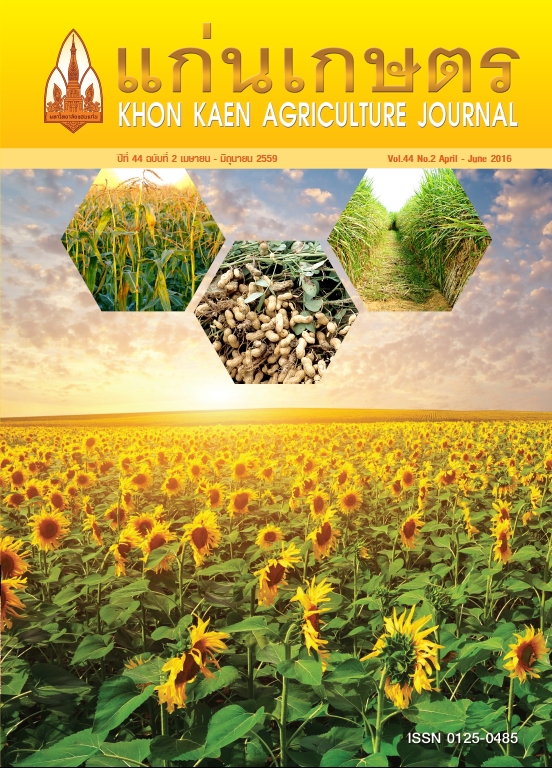Molecular Identification of Bipolaris cactivora on Dragon Fruit in Thailand
Main Article Content
บทคัดย่อ
A fruit rot disease observed in white-fleshed dragon fruit, Hylocereus undatus (Haworth) Britton & Rose, collected from Loei province, Thailand was studied to identify the causative agent. Common symptoms on the surface of the fruits were water-soaking brown spots with powdery signs. The diseased fruits were then isolated for the fungal pathogen. According to the morphology, Bipolaris cactivora (Petr.) Alcorn was the most possible one that caused the disease. To confirm this, the molecular identification and phylogenetic analysis using two gene sequences, internal transcribed spacer (ITS) amplified with ITS1 and ITS4 primers and elogation factor (EF) using 983F and 2218R primers were thus employed. Due to the statitical supports of high bootstrap score at 99% derived from Neighbour-joining method and potential interior propability, 100% calculated fron Baysian analysis, the fungal pathogen of rot disease on the dragon fruits was B. cactivora.
Article Details
เอกสารอ้างอิง
Ben-Ze’ev, I.S., I. Assouline, E. Levy, and G. Elkind. 2011. First report of Bipolaris cactivora causing fruit blotch and stem rot of dragon fruit (pitaya) in Israel. Phytoparasitica. 39: 195-197. Chand, R., S.P. Pandey, H.V. Singh, S. Kumar, and A.K. Joshi. 2003. Variability and its probable cause in the natural population of spot blotch pathogen Bipolaris sorokiniana of wheat (T. aestsivum) J. Plant Disease and Protection. 110: 27-35
Damm, U., P.W. Crous, and P.H. Fourie. 2008. A fissitunicate ascus mechanism in the Calosphaeriaceae, and novel species of Jattaea and Calosphaeria on Prunuswood. Persoonia. 20: 39-52. Durbin, R.D., L.H. Davis, and K.F. Baker. 1955. A Helminthosporium stem rot of cacti. Phytopathology. 45: 509-512.
Gramaje D, C. Agustí-Brisach, A. Pérez-Sierra, E. Moralejo, D. Olmo, L. Mostert, U. Damm, and J. Armengol. 2012. Fungal trunk pathogens associated with wood decay of almond trees on Mallorca (Spain). Persoonia. 28: 1-13.
He, P.F., H. Ho, X. Wu, M.S. Hou, and Y.Q. He. 2012. Bipolaris cactivora causing fruit rot of dragon fruit imported from Vietnam. Plant Pathol Quar. 2: 31-35.
Huelsenbeck, J.P., and B. Rannala. 2004. Frequentist properties of Bayesian posterior probabilities of phylogenetic trees under simple and complex substitution models. Syst Biol. 53: 904-13. Kim, J.H., M.I. Jeoung, I.H. Hyun, and Y.H. Kim. 2004. A Potential biotypes in Korean isolates of Bipolaris cactivora associated with stem rot of cactus. Plant Pathol J. 20: 165-171.
Manamgoda, D.S., A.Y. Rossman, L.A. Castlebury, P.W. Crous, H. Madrid, E. Chukeatirote, and K.D. Hyde. 2014. The genus Bipolaris. Stud Mycol. 79: 221-288.
Manamgoda, D.S., L. Cai, A.H. Bahkali, E. Chukeatirote, and K.D. Hyde. 2011. Cochliobolus: an overview and current status of species. Fungal Diversity. 51: 3-42.
Manamgoda, D.S., L. Cai, E.H.C. McKenzie, P.W. Crous, and H. Madrid. 2012. A phylogenetic and taxonomic re-evaluation of the Bipolaris-Cochliobolus-Curvulariacomplex. Fungal Diversity. 56: 131-144.
Mendoza L, L. Ajello, and J.W. Taylor. 2001. The taxonomic status of Lacazia loboi and Rhinosporidium seeberihas been finally resolved with the use of molecular tools. Rev Iberoam Micol. 18: 95-8.
Miller, S.L., and B. Buyck. 2002. Molecular phylogeny of the genus Russula in Europe with a comparison of modern infrageneric classifications. Mycol Res. 106: 259-276.
Oeurn, S., W. Jitjak, and N. Sanoamuang. 2015. Fungi on dragon fruit in Loei Province, Thailand and the ability of Bipolaris cactivora to cause post-harvest fruit rot. KKU Res J. 20: 405-418.
Ronquist, F., and J.P. Huelsenbeck. 2003. MrBayes 3: Bayesian phylogenetic inference under mixed models. Bioinformatics. 19(12): 1572-1574.
Sharma, T. 2003. Molecular diagnosis and application of DNA markers in the management of fungal and bacterial plant diseases. Indian J Biotechnol. 2: 99-109.
Sivanesan, A. 1987. Graminicolous species of Bipo-laris, Curvularia, Drechslera,Exserohilum and their teleomorphs. Mycological Paper No. 158.
Spatafora, J.W., G.H. Sung, D. Johnson, C. Hesse, B. O’Rourke, M. Serdani, R. Spotts, F. Lutzoni, V. Hofstetter, J. Miadlikowska, V. Reeb, C. Gueidan, E. Fraker, T. Lumbsch, R. Lu ̈cking, I. Schmitt, K. Hosaka, A. Aptroot, C. Roux, A.N. Miller, D.M. Geiser, J. Hafellner, G. Hestmark, A. E. Arnold, B. Bu ̈del, A. Rauhut, D. Hewitt, W.A. Untereiner, M.S. Cole, C. Scheidegger, M. Schultz, H. Sipman, and C.L. Schoch 2006. A five-gene phylogeny of Pezizomycotina. Mycologia. 98: 1018-1028.
Taba, S., N. Miyahira, K. Nasu, T. Takushi, and Z. Moromizato. 2007. Fruit rot of strawberry pear (pitaya) caused by Bipolaris cactivora. J Gen Plant Pathol. 73: 374-376.
Tarnowski T.L.B., A.J. Palmateer, and J.H. Crane. 2010. First report of fruit rot on Hylocereus undatus caused by Bipolaris cactivora in south Florida. Plant Dis. 94: 1506-1506.
Valente, P, J.P. Ramos, and O. Leoncini. 1999. Sequencing as a tool in yeast molecular taxonomy. Can J Microbiol. 45: 949-58.
White, T.J., T. Bruns, S. Lee, and J. Taylor. 1990. Amplification and direct sequencing of fungal ribosomal RNA genes for phylogenetics. PCR Protoc Guide Methods Appl. 18: 315-22.


